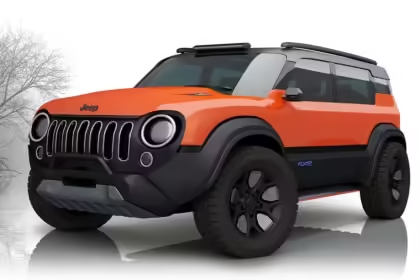Electric cars are no longer just a luxury option. The EV market has become even more competitive in 2025, with both affordability and performance being the focus. Motortrend highlights the top 10 electric cars in its latest list that are the cheapest but have the best features and range. If you are looking to buy a budget-friendly EV, this guide is perfect for you. Let’s take a look at the top 10 cheapest electric cars of 2025 that are both value for money and eco-friendly.
1. 2025 Nissan Leaf ($29,280)
The 2025 Nissan LEAF continues to be a compelling choice for urban EV enthusiasts. With a range spanning 149 to 212 miles, depending on the battery configuration, it caters to both daily commutes and short trips. The base model’s 40 kWh battery offers 147 horsepower, while the SV Plus trim boasts a 62 kWh battery delivering 214 horsepower. The LEAF’s compact design ensures a tight turning radius, enhancing maneuverability in city environments. Inside, passengers benefit from 42.1 inches of front legroom and 33.5 inches in the rear, providing ample space for a comfortable ride. Cargo capacity stands at 23.6 cubic feet with seats up, expanding to 30.0 cubic feet when folded, accommodating various storage needs. However, the LEAF’s peak charging speed is limited to 50 kW, resulting in longer charging sessions compared to some competitors. Additionally, the infotainment system and switchgear may not appeal to all users, and the absence of a one-pedal driving feature could be a drawback for those accustomed to that functionality.

| Pros | Cons |
|---|---|
| Compact size and agile handling make it ideal for city driving | Limited driving range and slower charging capabilities. |
| Comes equipped with practical driver assistance features. | Interior materials feel inexpensive, and the technology seems outdated. |
| Offers an affordable starting price below $30,000. | A new generation model is anticipated to arrive soon. |
2. 2025 Mini Cooper Electric ($33,050)
The 2025 Mini Cooper Electric car offers an exciting blend of performance and efficiency. The EV is equipped with a 40.7 kWh battery, delivers a zippy 0-60 mph acceleration in approximately 6.7 seconds. Making it perfect for the city commutes both swift and enjoyable. While the exact range and front/rear legroom specifications are yet to be disclosed, the EV supports fast charging capabilities between 75 kW and 95 kW, ensuring reduced downtime during recharging sessions. These features position the Mini Cooper Electric as a compelling choice for those seeking a stylish and responsive electric vehicle tailored for city life.

| Pros | Cons |
|---|---|
| Fast charging capabilities | Some other electric vehicles offer a longer range per charge |
| Expected to be fun and zippy to drive | Expected to be relatively expensive |
| Innovative circular touchscreen interface | Bold styling may not appeal to those seeking subtlety |
3. 2025 Hyundai Kona Electric ($34,270)
The 2025 Hyundai Kona Electric Limited offers a compelling blend of performance and practicality for EV enthusiasts. With an EPA-estimated range between 200 and 261 miles, it ensures confidence for both daily commutes and longer journeys. The vehicle supports a peak charging speed of 100 kW, facilitating quick replenishment of its 48.6 kWh battery pack. Inside, passengers enjoy generous legroom—41.7 inches in the front and 36.4 inches in the rear—enhancing comfort on the road. The Kona Electric car also boasts a cargo volume of 25.5 cubic feet with the seats up, providing ample space for luggage or groceries. Performance-wise, the Ultimate trim accelerates from 0 to 60 mph in a swift 6.6 seconds, delivering an engaging driving experience.

| Pros | Cons |
|---|---|
| Innovative interior and exterior design | Base model’s performance may not meet expectations |
| Spacious cabin | Higher-capacity battery comes with a significant price increase |
| Availability of two powertrain options | All-wheel drive (AWD) is not available |
4. 2025 Fiat 500e ($34,345)
Fiat 500e, which offers a blend of performance and practicality. Equipped with a 42 kWh battery, it provides an EPA-rated range of up to 149 miles, making it suitable for daily commuting. The 500e’s electric motor delivers 117 horsepower and 162 lb-ft of torque, enabling a 0-60 mph acceleration in 7.9 seconds. Its compact dimensions contribute to a tight turning radius, enhancing maneuverability in urban settings. The interior offers 41.8 inches of front legroom and 29.4 inches in the rear, accommodating passengers comfortably. With 7.5 cubic feet of cargo space, the 500e is practical for everyday use. While the peak charging speed of 85 kW isn’t the fastest available, it allows for reasonable charging times, balancing performance with efficiency.

| Pros | Cons |
|---|---|
| Returns with electric power | Limited driving range |
| Charming retro design | Tight rear seating |
| Fun driving experience | Complicated navigation system |
5. 2025 Chevrolet Equinox EV ($34,995)
The 2025 Chevrolet Equinox EV is poised to make a significant impact in the electric SUV market. With an estimated range of 285 to 319 miles, it offers ample distance for both daily commutes and longer journeys. The 85 kWh battery supports a peak charging speed of 150 kW, facilitating efficient recharging sessions. Performance enthusiasts will appreciate the AWD RS variant, which accelerates from 0 to 60 mph in 5.7 seconds. Inside, passengers benefit from generous legroom—41.6 inches in the front and 38.0 inches in the rear—ensuring comfort on the go. The cargo space is versatile, offering 26.4 cubic feet with seats up and expanding to 57.2 cubic feet when folded down. Overall, the Equinox electric car combines practicality with performance, making it a compelling choice for those considering an electric SUV.

| Pros | Cons |
|---|---|
| Affordable starting price | Lower trims lack certain features |
| Impressive driving range | Slower charging speeds compared to competitors |
| Large infotainment displays | Delayed availability of base model |
6. 2025 Volvo EX30 ($36,145)
The 2025 Volvo EX30 is poised to make a significant impact in the electric car market. With an estimated range of 265 to 275 miles, it offers practicality for daily commutes and longer journeys. The Twin Motor Performance variant stands out, delivering a remarkable 0 to 60 mph acceleration in just 3.4 seconds, making it the fastest-accelerating car in Volvo’s lineup. Equipped with a 69 kWh battery and capable of peak charging speeds up to 153 kW, the EX30 can recharge from 10% to 80% in approximately 27 minutes, minimizing downtime during trips. While specific legroom measurements haven’t been released, the vehicle provides a cargo volume of 31.9 cubic feet with the seats down, offering ample space for luggage or gear.

| Pros | Cons |
|---|---|
| Striking design | Limited physical buttons |
| Solid range | Awaiting Cross Country model |
| Approachable starting price |
7. 2025 Hyundai Ioniq6 ($38,900)
This model offers a versatile range between 240 and 342 miles, catering to both daily commutes and longer journeys. Its peak charging speed of 239 kW ensures rapid replenishment of the battery, minimizing downtime during travel. Inside, passengers benefit from generous legroom—42.3 inches in the front and 39.2 inches in the rear—providing a comfortable experience for all occupants. While the cargo volume stands at 11.6 cubic feet, sufficient for everyday needs, the vehicle’s performance is notable with a 0–60 mph acceleration in just 6.0 seconds for the RWD Long Range SE variant. The base battery capacity of 53 kWh strikes a balance between weight and efficiency, contributing to the vehicle’s commendable range and performance metrics. This EV embodies the advancements in electric vehicle technology, offering a harmonious blend of range, speed, and interior comfort.

| Pros | Cons |
|---|---|
| Superior to Tesla Model 3 | Uninspiring interior design |
| Extended range with rapid charging | Unconventional exterior aesthetics |
8. 2025 Kia Niro EV ($40,600)
The Kia Niro EV stands out with its EPA-estimated range of 253 miles per charge, powered by a 64.8 kWh battery pack. Its front and rear legroom, measuring 41.5 and 36.9 inches respectively, ensures ample space for passengers. The cargo volume offers 22.8 cubic feet with seats up and expands to 63.7 cubic feet when folded down, providing versatile storage options. Performance-wise, the Niro EV accelerates from 0 to 60 mph in 6.7 seconds, delivering a responsive driving experience. However, its peak DC fast-charging rate is 85 kW, which is modest compared to some competitors.

| Pros | Cons |
|---|---|
| Comfortable front seats | Frustrating infotainment system and controls |
| Impressive maneuverability with a tight turning radius | Some interior materials feel cheap |
| Quiet and smooth ride | Lacks one-pedal driving capability |
9. 2025 Nissan Ariya ($41,500)
The Nissan Ariya stands out in the electric car market with its impressive specifications. Offering a range between 205 and 304 miles, it caters to both daily commutes and longer journeys. The vehicle supports a peak charging speed of 130 kW, ensuring efficient recharging sessions. Inside, passengers benefit from generous legroom, boasting 42.3 inches in the front and 37.0 inches in the rear, enhancing overall comfort. The cargo space is versatile, providing 21.0 cubic feet with seats up, and expanding when seats are folded down. Performance enthusiasts will appreciate the Platinum+ e-4ORCE variant, which accelerates from 0 to 60 mph in just 5.0 seconds. The base model comes equipped with a 63 kWh battery, balancing efficiency and power. These features collectively position the Ariya as a compelling choice for those seeking a blend of performance, comfort, and practicality in an electric SUV.

| Pros | Cons |
|---|---|
| Upscale, spacious cabin | No one-pedal driving |
| Comfortable front seats | Slow charging rate |
| Competent ProPilot Assist | Could use more range |
10. 2025 Volkswagen ID4 ($41,760)
The Volkswagen ID.4 exemplifies the evolution of electric SUVs, offering a harmonious blend of performance, comfort, and practicality. With an EPA-estimated range between 209 and 291 miles, depending on the configuration, it ensures drivers can embark on extended journeys with confidence. The vehicle’s acceleration is noteworthy, achieving 0 to 60 mph in just 5.2 seconds in the Pro S AWD variant, showcasing its spirited performance capabilities. Inside, passengers are treated to a spacious cabin, boasting 41.1 inches of front legroom and 37.6 inches in the rear, ensuring comfort on every trip. The ID.4 also offers ample cargo space, providing 30.3 cubic feet with the seats up and expanding to 64.2 cubic feet when the rear seats are folded down, catering to diverse storage needs. Additionally, with a peak charging speed of 135 kW, recharging the ID.4 is both swift and efficient, minimizing downtime and maximizing driving pleasure.

| Pros | Cons |
|---|---|
| Comfortable front seats | Frustrating infotainment system and controls |
| Excellent maneuverability with a tight turning radius | Some interior materials feel low-quality |
| Quiet and smooth ride | Lacks the capability for one-pedal driving |








